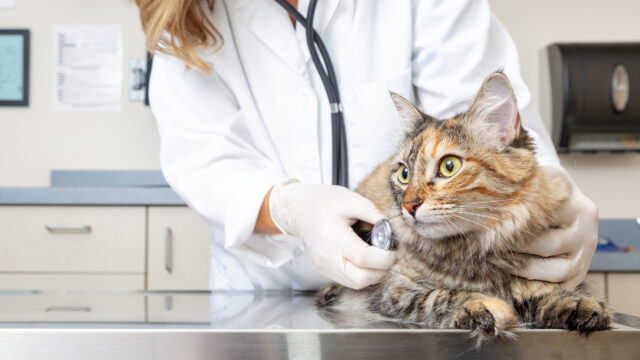Do you know how to take your cat’s vital signs?
If not, now is the time to learn! Don’t worry though, learning how to take vitals isn’t as complicated as it may seem, and it might just make the difference in your cat’s health.
The three elements of cat vital signs are temperature, heart rate, and respiratory rate. Veterinarians use these vital signs as an overview of a cat’s immediate health. By learning how to take your cat’s vital signs at home, you and your furry best friend can stay on top of their health and ahead of any illness that may surface.
But how do you take a cat’s vital signs? And what’s normal for cats when it comes to temperature, heart rate, and respiratory rate?

We’ve got the answers you need! Read on and learn how to take a cat’s vital signs with instructions from veterinary experts. By taking these simple measurements at home, you’ll establish a baseline of what’s normal for your feline. The slightest variations in their average measurements can alert you to potential issues early on, making them easier for you and kitty to overcome.
The Vital Signs
Cat Vital Sign #1: Temperature
An adult cat’s normal body temperature runs between 100.5 to 102.5 degrees Fahrenheit (38.1°C and 39.2°C).
But how can you tell if your cat has a fever? It’s a common belief that touching a cat’s nose can reveal if the kitty is feeling feverish. But this isn’t true. The most accurate way to gauge a cat’s temperature is with a thermometer. But how do you take a cat’s temperature?

How to Take a Cat’s Temperature
The most accurate way to take a cat’s temperature is rectally. This may not be something your cat allows and if that’s the case, leave it to the vet to avoid injury to you or your kitty. If your cat does allow the invasion, then veterinarian Dr. Marty Becker offers these instructions for taking a cat’s temperature:
- Use a glass thermometer or a digital rectal thermometer.
- Before inserting, lubricate the thermometer with a water-based medical lubricant.
- Gently and slowly insert the thermometer 1 to 2 inches into cat’s rectum and leave it in place for about two minutes for glass or until the beep for digital.
The Cornell University College of Veterinary Medicine offers a 5-part video series on how to take a cat’s temperature. You can also ask your veterinarian to demonstrate to give you a better idea.

Do not take a cat’s temperature orally. Putting a thermometer in a cat’s mouth can result in breakage that could cause harm.
If you don’t have a thermometer or feel squeamish about taking kitty’s temp when they aren’t feeling well, then look for the signs of fever in cats. PetMD lists feline fever symptoms as:
- Loss of appetite
- Depression
- Fatigue
- Listless behavior
- Decreased water intake
- Decreased grooming
- Shivering
- Rapid breathing
Contact your vet immediately if you notice any of these symptoms in your cat.
Cat Vital Sign #2: Heart Rate
A resting human heart beats between 60 – 100 times per minute on average, but a cat’s normal heart rate is much faster. The average heart rate of an adult cat ranges between 140 to 220 bpm.

But how do you find a cat’s pulse to measure heart rate?
Dr. Becker instructs, “Place your hand on his left side, just behind its front leg. You should feel the heart beating.”
Once you’ve located the pulse, you can then determine your cat’s heart rate with the aid of stopwatch, clock with a second hand, or even an app on your phone. “Count the number of beats during 15 seconds. Multiply that number by four to get the beats per minute.”
If you determine your cat’s heart rate to be irregular, too fast or slow, then contact the vet as this could be a sign of illness.

Cat Vital Sign #3: Respiratory Rate
The respiratory rate measures the number of breaths taken per minute while at rest. Healthy adult cats present with an average respiratory rate of 20 to 30 breaths per minute. To measure your cat’s breathing rate, wait until nap time and make sure kitty dear isn’t purring during the count.
Veterinary cardiac-specialist Dr. Sonya G. Gordon details instructions on how to measure a cat’s respiratory rate:
- Watch the movement of your cat’s chest rising and falling as he breathes. One breath equals the chest moving in and out once.
- Using a watch or smartphone, count how many breaths occur during a 30-second period.
- Multiply the number of breaths counted by 2 to get the number of breaths in 60 seconds.
Taking your cat’s breathing rate is an easy process that plays an important role in keeping cats healthy.

Dr. Gordon explains the importance of monitoring breathing rates at home as “increases in your pet’s breathing rate while resting quietly or sleeping is a very important early clue (clinical sign) that your pet may be developing heart failure.”
Breathing problems in cats aren’t just limited to heart issues though. From colds to stress, there are many illnesses which affect a cat’s respiratory rate. No matter what, if your kitty is panting or laboring to breathe, call the vet right away.

Don’t wait to take your cat’s vital signs for the first time if you notice they aren’t feeling well. It’s a good idea to take vital signs from time to time and while your cat is healthy in order to establish a baseline for your feline. Knowing how to take your cat’s vital signs is another way to ensure your kitty lives the happiest and healthiest life possible.
H/T: www.startribune.com
